AMD Ryzen 5 2400G and Ryzen 3 2200G Core Frequency Scaling: An Analysis
by Gavin Bonshor on June 20, 2018 10:05 AM EST- Posted in
- CPUs
- AMD
- Zen
- APU
- Vega
- Ryzen
- Ryzen 5
- Ryzen 3
- Scaling
- CPU Frequency
- Ryzen 3 2200G
- Ryzen 5 2400G
Discrete Graphics Performance, Cont
As stated on the first page, here we take both APUs from 3.5 GHz to 4.0 GHz in 100 MHz increments and run our testing suite at each stage. This is a 14.3% increase in clock speed, however when it comes to gaming it can be unpredictable where those gains are going to come from.
For our gaming tests, we are only concerned with real-world resolutions and settings for these games. It would be fairly easy to adjust the settings in each game to a CPU limited scenario, however the results from such a test are mostly pointless and non-transferable to the real world in our view. Scaling takes many forms, based on GPU, resolution, detail levels, and settings, so we want to make sure the results correlate to what users will see day-to-day.
Thief
Thief has been a long-standing title in the hearts of PC gamers since the introduction of the very first iteration back in 1998 (Thief: The Dark Project). Thief is the latest reboot in the long-standing series and renowned publisher Square Enix took over the task from where Eidos Interactive left off back in 2004. The game itself uses the UE3 engine and is known for optimised and improved destructible environments, large crowd simulation and soft body dynamics.

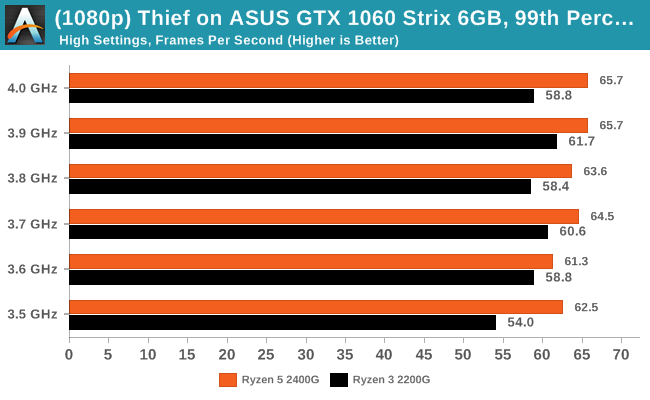
Shadow of Mordor
The next title in our testing is a battle of system performance with the open world action-adventure title, Middle Earth: Shadow of Mordor (SoM for short). Produced by Monolith and using the LithTech Jupiter EX engine and numerous detail add-ons, SoM goes for detail and complexity. The main story itself was written by the same writer as Red Dead Redemption, and it received Zero Punctuation’s Game of The Year in 2014.
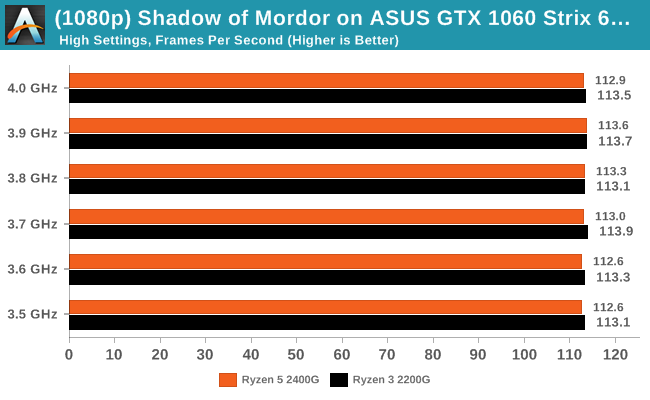
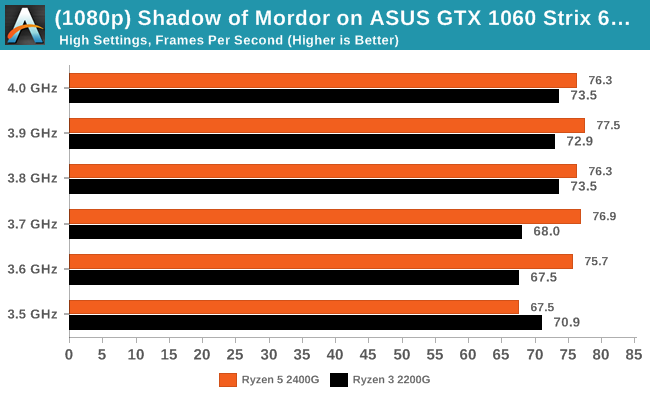
F1 2017
Released in the same year as the title suggests, F1 2017 is the ninth variant of the franchise to be published and developed by Codemasters. The game is based around the F1 2017 season and has been and licensed by the sports official governing body, the Federation Internationale de l’Automobile (FIA). F1 2017 features all twenty racing circuits, all twenty drivers across ten teams and allows F1 fans to immerse themselves into the world of Formula One with a rather comprehensive world championship season mode.
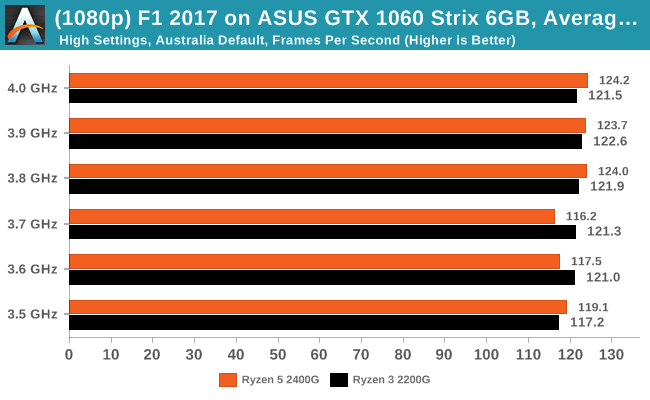
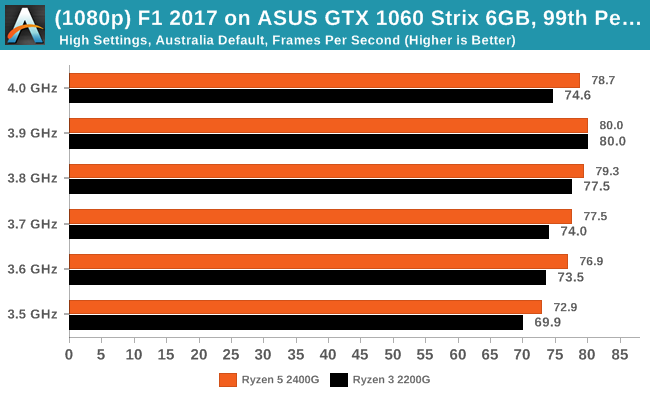


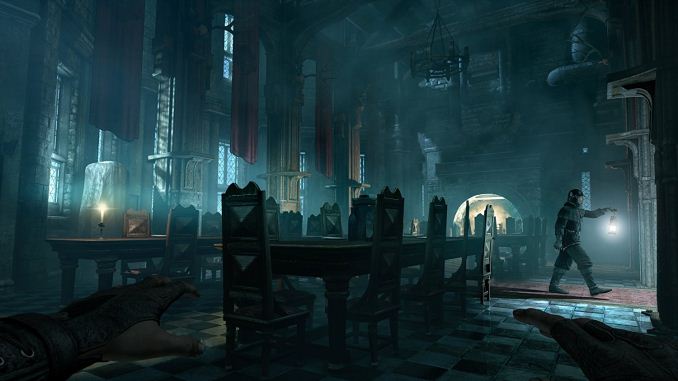

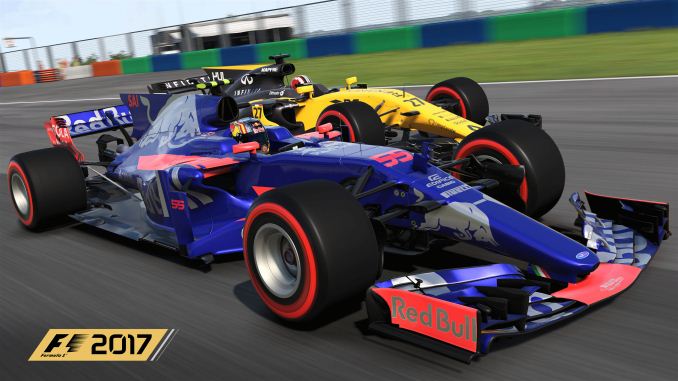








29 Comments
View All Comments
koekkoe - Thursday, June 21, 2018 - link
Improvements beyond 15% are probably anomalies.msroadkill612 - Thursday, June 21, 2018 - link
I kinda wish APU reviewers were less focused on comparisons with the nearest price dgpu PC (garbage no one would actually buy if they went the dgpu route - they would spend hundreds more), and accepted there are many who, having decided on the apu route, sensibly want to do it properly and spend the small premium that takes.For your forthcoming APU memory OC review, IMO, stock cooling on the majority of 2400 ApuS is not real world. Stock is a false economy.
You are getting a ~free (minimalist, but cutting edge vega ecosystem) GPU, and luckily, can better cool both processors with a single improved cooler. $30- $50 doesn't seem too much to budget for decent air cooling. Nor does $220-240 for decent 16GB ram.
The game changing dynamic automatic overclocking that comes with APUs (also on a new process to zen1, which AMD call 14nm+) and Zen+ CPUs, is wonderful, but only as good as the thermal envelope your cooling allows it.
Further, what seems to get overlooked in the fuss about latency trumping clock speed for memory perf, is that mem clock also sets Fabric bus clock speed.
The effects of improving this vital and fundamental zen metric may well go un-noticed by benchmarks for some time, but as the zen/fabric/vega APU ecosystem beds down, Fabric bus speed ~will matter a lot. ~everything must pass through this control point, so its inevitably a bottle neck.
Ratman6161 - Thursday, June 21, 2018 - link
"I kinda wish APU reviewers were less focused on comparisons with the nearest price dgpu PC (garbage no one would actually buy if they went the dgpu route - they would spend hundreds more),"A GTX 1060 is "garbage no one would actually buy"? I'm not into games any more, but back in my younger days I was...and didn't have a lot of money to spend. The graphics aren't really important for my work so I would choose a CPU based on my work requirements and then indulge myself a little on a graphics card that was affordable to me. I used to set a $150 to $200 limit on how much I would spend on graphics and get whatever seemed to be the most bang for the buck in that range. At $230 (cheapest GTX 1060 on New Egg) the 1060 would actually be a bit above my range. Anyway integrated graphics weren't an option then, at least in my situation.
so what if I was a gamer today but didn't have much cash and wanted the best I could get with a small amount of money? Well, Looking at Microcenter which is my go to place for CPU's and motherboards, The 2200G is the cheapest Ryzen CPU available at $80 while the 2400g is $150. In the test results, the 2200g + GTX 1060 performs better than the 2400g with integrated graphics. So in order of price/performance you get (from highest performing to lowest performing):
2400g + 1060 $380
2200G + 1060 $310
2400G + Integrated $150
2200g + integrated $80
If you want the ultimate in cheap, the 2200G is the way to go. If you want something better than the 2400G you could move up to the 2200G + 1060. The 2400 + 1060 combo doesn't make any sense because for the same price I can get an R51600 and add the 1060 to that. Now if it were me (which it isn't :) ), for cheap gaming, i'd probably consider something like a 2200G over clocked as high as I could get it combined with a GTX1050 or similar for $80+$140 = $220. I'd be using the 2200G not for its integrated graphics but because its the cheapest Ryzen I can get right now and its over clockable.
Spunjji - Friday, June 22, 2018 - link
Yeah, I currently have a 1050Ti because it's all I could afford. I game quite a lot. If I had a little more flexibility I'd have pushed to a 1060 and been very happy.Not everyone's highest financial priority is a GPU, even when games are their main source of leisure.
V900 - Friday, September 28, 2018 - link
Nothing wrong with a 1050 or 1060.PC Gamers have just been spoiled by massive performance jumps every generation, and been taught that new=doubleplusgood and old=slowgarbage.
In reality we reached "good enough" a few generations ago.
Heck, look at consoles: I don't see any PS4 gamers complain that their 5 year old GPUs are slow and "garbage".
V900 - Friday, September 28, 2018 - link
Absolutely right! Its been a few years since you could reasonably describe a low end GPU as 'garbage'.If you play games that arent very demanding in terms of graphics (or if youre fine with 30 fps) you can get an Nvidia 1030 for 80-100$
Nothing garbage about that card.
Spend an extra 50$ and you can buy the Nvidia 1050 (130$-150$) and run pretty much any game at 1080p with high settings.
And of course, 100$-200$ can also get you really far if you dont mind a used GPU. Ive seen GTX 970s and 980s in that price range.
boozed - Thursday, June 21, 2018 - link
I just wish an article entitled "An Analysis" included some analysis.V900 - Friday, September 28, 2018 - link
Or if you REALLY want to increase your performance and run 60 fps games at maxed out settings, you could take the 300$ you want to spend on a cooler and "decent" 16GB RAM, and instead get an Nvidia 1050 and 8 GB RAM.And you'll have cash left over for a good game or two.
Nvidia 1030 (or a 750TI) costs less than 100$ on Newegg.
Nvidia 1050 costs around 150$
AntonErtl - Thursday, June 21, 2018 - link
I find the big differences in the CPU results between both APUs at the same clock speed quite surprising. It seems that for some benchmarks SMT (aka Hyperthreading) gives substantial benefits after all. So thanks for the good work and I wish you a speedy recovery.Concerning iGPU overclocking, Computerbase (German) recently had a piece https://www.computerbase.de/2018-06/raven-ridge-ap... on that. One thing worthy of not is that 1350-1450MHz did not work on their iGPUs, but higher overclocks (1500MHz, and, with more voltage, more) worked. Their explanation was that voltage was set too low for the middle frequencies.
dromoxen - Thursday, June 21, 2018 - link
Come what may , these are still budget solutions , adding 16gb of expensive fast ram and best quality Coolers defeats the purpose ... and remember Dgpu are available on the 2nd hand market , esp things like gtx960,970 so adding one doesn't need to break the bank. that's where your upgrade money should go .